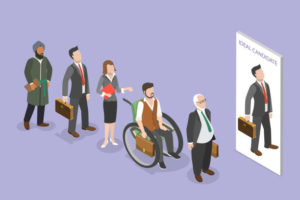 As we celebrate Diversity Month, it’s essential to reflect on the hidden assumptions that shape our perspectives. Implicit biases—unconscious attitudes or stereotypes—can influence our behavior and decision-making without us realizing it. Recognizing and challenging these biases is not only an act of self-care but a vital step toward creating more inclusive environments in our workplaces and communities.
As we celebrate Diversity Month, it’s essential to reflect on the hidden assumptions that shape our perspectives. Implicit biases—unconscious attitudes or stereotypes—can influence our behavior and decision-making without us realizing it. Recognizing and challenging these biases is not only an act of self-care but a vital step toward creating more inclusive environments in our workplaces and communities.
Implicit bias refers to the automatic and often unintentional associations we make about people based on their race, gender, age, or other characteristics. These biases are formed through exposure to cultural stereotypes and personal experiences, and they can affect our perceptions, judgments, and actions in subtle ways. While we may consciously reject prejudice, implicit biases can still lurk beneath the surface, influencing how we interact with others. Acknowledging that we all possess these biases is a powerful starting point for change.
Self-reflection is crucial in identifying and interrupting implicit biases. During Diversity Month, consider setting aside time for regular self-check-ins. Ask yourself reflective questions like:
- What assumptions am I making about others?
- How do my experiences and background shape my perceptions?
- In what situations have I noticed my judgments might be influenced by bias?
Mindfulness practices can be especially useful here. By becoming more aware of our thoughts and emotions in the moment, we create space to notice biased thinking as it arises. This increased self-awareness not only helps us understand our internal processes but also empowers us to choose a different response. Keeping a journal of your reflections can be a tangible way to track your progress over time.
Once you’ve identified instances of implicit bias, the next step is to challenge them actively. One effective method is to practice cognitive restructuring, a technique borrowed from cognitive-behavioral therapy (CBT). This involves:
- Recognizing the Bias: Become aware when a biased thought surfaces.
- Questioning Its Validity: Ask yourself whether this thought is based on objective evidence or merely a stereotype.
- Reframing Your Perspective: Replace the biased thought with a more balanced, fact-based view. For instance, if you catch yourself making assumptions about someone’s capabilities based on their appearance, remind yourself of their unique strengths and past achievements.
Another useful strategy is to expose yourself to counter-stereotypical examples. Engaging with diverse perspectives—whether through reading, conversations, or community events—can help challenge and reshape the automatic associations your mind has formed. This process is not about forcing yourself to adopt a particular viewpoint; rather, it’s about expanding your understanding and appreciating the complexity of individuals beyond surface-level characteristics.
Interrupting implicit biases is an ongoing process. Here are some practical tips to help in day-to-day situations:
- Pause Before Acting: When you feel a snap judgment forming, take a moment to pause and breathe. This brief pause can help disrupt automatic responses and give you a chance to reassess the situation.
- Engage in Active Listening: Practice listening fully without judgment. By focusing on what the other person is saying, you create a more authentic connection that transcends pre-existing assumptions.
- Seek Feedback: Invite trusted colleagues or friends to provide honest feedback about your interactions. They might notice patterns that you have overlooked.
- Commit to Lifelong Learning: Implicit bias is a complex and evolving topic. Regularly attend workshops, read relevant literature, and participate in discussions that challenge your current viewpoints.
As we honor Diversity Month, let us commit to a journey of self-examination and growth. Implicit biases are not definitive of who we are, but they do offer insight into areas where we can improve. By checking in with ourselves, challenging automatic thoughts, and actively interrupting biased behaviors, we create a more inclusive environment not only for those around us but for ourselves as well.
Embrace this opportunity to learn, evolve, and build connections that celebrate the rich tapestry of our diverse world. If you would like assistance in challenging your implicit bias or like to explore ways to celebrate diversity in your community and workplaces our counselors at Capital EAP are available to help guide you on this journey. You can reach out to us at 518-465-3813 to connect with our intake team, who can help you set up an appointment.
By: Denelle Abel, LMHC, EAP Clinical Supervisor
